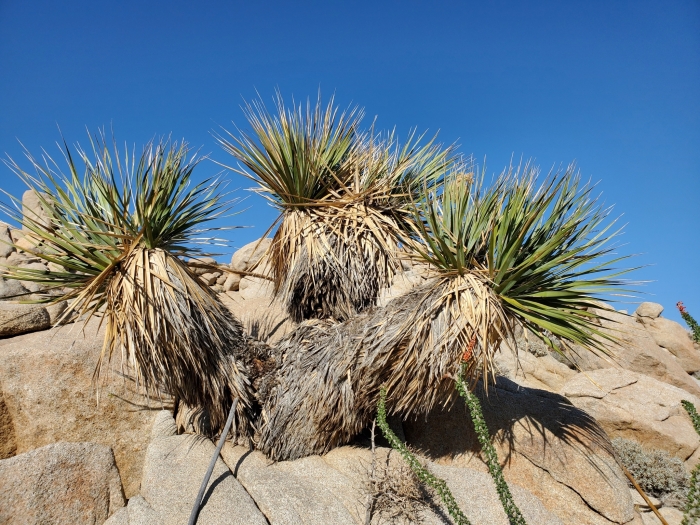Bigelow’s Nolina
(Nolina bigelovii)
Bigelow’s Nolina (Nolina bigelovii)
/
/

Bob Miller
CC BY 4.0
Image By:
Bob Miller
Recorded By:
Copyright:
CC BY 4.0
Copyright Notice:
Photo by: Bob Miller | License Type: CC BY 4.0 | License URL: http://creativecommons.org/licenses/by/4.0/ | Rights Holder: Bob Miller | Publisher: iNaturalist | Date Created: 2021-02-27T15:15:42-08:00 |




















































Estimated Native Range
Summary
Nolina bigelovii, commonly known as Bigelow’s Nolina, is an evergreen perennial plant that can take the form of a shrub, subshrub, or tree, and is native to desert regions such as the Mojave and Sonoran Deserts in the Southwestern USA as well as Mexico. It often grows on rocky slopes and in gravelly soils. The trunklike stem, which may exceed 2 meters (6.6 ft) in length, is often partially underground, contributing to its drought tolerance. The semi-stiff, shreddy leaves are arranged in dense rosettes, with each rosette capable of bearing up to 150 leaves. The leaves have thick, fleshy bases that are much wider than the rest of the blade, an adaptation to arid conditions. The plant produces a towering inflorescence that may approach 4 meters (13 ft) in height, with small flowers each having six whitish tepals a few millimeters in length. Flowering typically occurs from late spring to early summer, and the flowers are not particularly showy but are interesting upon close inspection.
Bigelow’s Nolina is valued for its unique sculptural form and its ability to thrive in hot, dry climates, making it a suitable choice for xeriscaping and desert gardens. It is also used as an accent plant in rock gardens or as a container specimen. In cultivation, it requires full sun exposure and minimal water, making it an easy-care plant for water-wise gardens. It prefers well-drained soils, whether sandy or gravelly, and is tolerant of poor fertility. While generally disease-free, it can be susceptible to root rot if overwatered. This plant is not known for aggressive roots or significant pest problems. It is not typically invasive when grown outside its native range, but gardeners should always monitor plants for unexpected spread.CC BY-SA 4.0
Bigelow’s Nolina is valued for its unique sculptural form and its ability to thrive in hot, dry climates, making it a suitable choice for xeriscaping and desert gardens. It is also used as an accent plant in rock gardens or as a container specimen. In cultivation, it requires full sun exposure and minimal water, making it an easy-care plant for water-wise gardens. It prefers well-drained soils, whether sandy or gravelly, and is tolerant of poor fertility. While generally disease-free, it can be susceptible to root rot if overwatered. This plant is not known for aggressive roots or significant pest problems. It is not typically invasive when grown outside its native range, but gardeners should always monitor plants for unexpected spread.CC BY-SA 4.0
Plant Description
- Plant Type: Shrub, Subshrub
- Height: 3-6 feet
- Width: 3-6 feet
- Growth Rate: Slow
- Flower Color: White, Cream
- Flowering Season: Spring
- Leaf Retention: Evergreen
Growth Requirements
- Sun: Full Sun
- Water: Low, Very Low
- Drainage: Medium, Fast
Common Uses
Bee Garden, Low Maintenance, Rock Garden
Natural Habitat
native to desert regions such as the Mojave and Sonoran Deserts in the Southwestern USA as well as Mexico
Other Names
Common Names: Bigelow Bear-Grass, Bigelow Nolina, Beargrass
Scientific Names: , Nolina bigelovii, Dasylirion bigelovii, Nolina bigelovii var. bigelovii, Beaucarnea bigelovii,
GBIF Accepted Name: Nolina bigelovii (Torr.) S.Watson